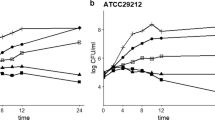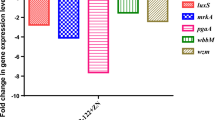Abstract
The resistance of bacteria to antibiotics is a major public health issue. Klebsiella pneumoniae is a type exemplification of multi-resistant enterobacteria. Its high biofilm forming capacity is a major factor in the recurrent infection of the intestinal tract. In this study, the intrinsic mechanism of secondary growth of K. pneumoniae in response to antibiotics and the inhibition effect of probiotic supernatant on biofilm formation after antibiotic treatment were investigated in a polyester nonwoven chemostat bioreactor. The experimental results showed that the c-di-GMP content in the cells increased after treatment with levofloxacin, leading to the formation of a thick biofilm due to an increase in the production of extracellular polymer substance (EPS) and type 3 fimbriae. Biofilm prevents the mass transfer of levofloxacin and protects K. pneumoniae cells from being killed by levofloxacin. Under suitable conditions, K. pneumoniae cells on the biofilm enter into the suspension for secondary growth. Moreover, the inhibition of probiotic supernatant on the biofilm formation was mainly due to the reduced expression of yfiN and mrkJ genes, and the decreased concentration of c-di-GMP in cells, as well as the less secretion of EPS. At the same time, the decrease in the concentration of c-di-GMP also reduced the expression of the mrkABCDF gene and prevented the synthesis of the type 3 fimbriae. The results would help to understand the mechanism of antibiotic resistance of pathogenic bacteria and to provide evidence to address this problem through the use of probiotics.






Similar content being viewed by others
References
Macfarlane S (2014) Antibiotic treatments and microbes in the gut. Environ Microbiol 16(4):919–924
Turnbaugh PJ, Hamady M, Yatsunenko T, Cantarel BL, Duncan A, Egholm M (2009) A core gut microbiome in obese and lean twins. Nature 457(7228):480–488
Cotter PD, Stanton C, Ross RP, Hill C (2012) The impact of antibiotics on the gut microbiota as revealed by high throughput DNA sequencing. Discov Med 13(70):193–199
Chen T, Li S, Wei H (2014) Antibiotic resistance capability of cultured human colonic microbiota growing in a chemostat model. Appl Biochem Biotech 173(3):765–774
Paczosa MK, Mecsas J (2016) Klebsiella pneumoniae: going on the offense with a strong defense. Microbiol Mol Biol Rev 80(3):629–661
Tzouvelekis LS, Miriagou V, Kotsakis SD, Spyridopoulou K, Athanasiou E, Daikos GL (2013) KPC-producing, multidrug-resistant Klebsiella pneumoniae sequence type 258 as a typical opportunistic pathogen. Antimicrob Agents Ch 57(10):5144–5146
Stewart PS, Costerton JW (2001) Antibiotic resistance of bacteria in biofilms. Lancet 358(9276):135–138
Lebeaux D, Ghigo JM, Beloin C (2014) Biofilm-related infections: bridging the gap between clinical management and fundamental aspects of recalcitrance toward antibiotics. Microbiol Mol Biol Rev 78(3):510–543
Pan T, Xiang H, Diao T, Ma W, Shi C, Xu Y, Xie Q (2019) Effects of probiotics and nutrients addition on the microbial community and fermentation quality of peanut hull. Bioresour Technol 273:144–152
Zhang J, Liu M, Xu J, Qi Y, Zhao N, Fan M (2020) First insight into the probiotic properties of ten Streptococcus thermophiles strains based on in vitro conditions. Curr Microbiol 77:343–352
James KM, MacDonald KW, Chanyi RM, Cadieux PA, Burton JP (2016) Inhibition of Candida albicans biofilm formation and modulation of gene expression by probiotic cells and supernatant. J Med Microbiol 65(4):328–336
Lagrafeuille R, Miquel S, Balestrino D, Vareille-Delarbre M, Chain F, Langella P, Forestier C (2018) Opposing effect of Lactobacillus on in vitro Klebsiella pneumoniae in biofilm and in an in vivo intestinal colonization model. Benef Microbes 9(1):87–100
Hengge R (2009) Principles of c-di-GMP signaling in bacteria. Nat Rev Microbiol 7:263–273
Ross P, Weinhouse H, Aloni Y, Michaeli D, Weinberger-Ohana P, Mayer R, Braun S, de Vroom E, van der Marel GA, van Boom JH, Benziman M (1987) Regulation of cellulose synthesis in Acetobacter xylinum by cyclic diguanylic acid. Nature 325:279–281
Thormann KM, Duttler S, Saville RM, Hyodo M, Shukla S, Hayakawa Y, Spormann AM (2006) Control of formation and cellular detachment from Shewanella oneidensis MR-1 biofilms by cyclic di-GMP. J Bacteriol 188(7):2681–2691
Chua SL, Sivakumar K, Rybtke M, Yuan M, Andersen JB, Nielsen TE, Yang L (2015) C-di-GPM regulates Pseudomonas aeruginosa stress response to tellurite during both planktonic and biofilm modes of growth. Sci Rep 5:10052–10067
Schroll C, Barken KB, Krogfelt KA, Struve C (2010) Role of type 1 and type 3 fimbriae in Klebsiella pneumoniae biofilm formation. BMC Microbiol 10(1):179–189
Macfarlane GT, Macfarlane S, Gibson GR (1998a) Validation of a three-stage compound continuous culture system for investigating the retention time on the ecology and metabolism of bacteria in the human colon. Microb Ecol 35:180–187
Colclasure VJ, Soderquist TJ, Lynch T, Schubert N, McCormick DS, Urrutia E, Knickerbocker C, McCord D, Kavouras JH (2015) Coliform bacteria, fabrics, and the environment. Am J Infect Control 43(2):154–158
Macfarlane GT, Macfarlane S, Gibson GR (1998b) Validation of a three-stage compound continuous culture system for investigating the effect of retention time on the ecology and metabolism of bacteria in the human colon. Microb Ecol 35(2):180–187
De Boever P, Deplancke B, Verstraete W (2000) Fermentation by gut microbiota cultured in a simulator of the human intestinal microbial ecosystem is improved by supplementing a soygerm powder. J Nutr 130(10):2599–2606
Frølund B, Palmgren R, Keiding K, Nielsen PH (1996) Extraction of extracellular polymers from activated sludge using a cation exchange resin. Water Res 30(8):1749–1758
Wang C, Liu S, Xu X, Zhao C, Yang F, Wang D (2017) Potential coupling effects of ammonia-oxidizing and anaerobic ammonium-oxidizing bacteria on completely autotrophic nitrogen removal over nitrite biofilm formation induced by the second messenger cyclic diguanylate. Appl Microbiol Biotechnol 101(9):3821–3828
Wu C, Cheng YY, Yin H, Song XN, Li WW, Zhou XX, Yu HQ (2013) Oxygen promotes biofilm formation of Shewanella putrefaciens CN32 through a diguanylate cyclase and an adhesin. Sci Rep 3:1945
Zhou J, Xie J, Liao H, Wang X (2014) Overexpression of β-expansin gene GmEXPB2 improves phosphorus efficiency in soybean. Physiol Plantarum 150(2):194–204
Wang H, Yan Y, Rong D, Wang J, Wang HD, Liu ZZ, Wang JP, Yang RF, Han YP (2016) Increased biofilm formation ability in Klebsiella pneumoniae after short-term exposure to a simulated microgravity environment. MicrobiologyOpen 5(5):793–801
Chookaew T, Sompong O, Prasertsan P (2014) Biohydrogen production from crude glycerol by immobilized Klebsiella sp. TR17 in a UASB reactor and bacterial quantification under non-sterile conditions. Int J Hydrogen Energ 39(18):9580–9587
Amann RI, Ludwig W, Schleifer KH (1995) Phylogenetic identification and in situ detection of individual microbial cells without cultivation. Microbiol Mol Biol Rev 59(1):143–169
Johnson JG, Clegg S (2010) Role of MrkJ, a phosphodiesterase, in type 3 fimbrial expression and biofilm formation in Klebsiella pneumoniae. J Bacteriol 192(15):3944–3950
Langstraat J, Bohse M, Clegg S (2001) Type 3 fimbrial shaft (MrkA) of Klebsiella pneumoniae, but not the fimbrial adhesin (MrkD), facilitates biofilm formation. Infect Immun 69:5805–5812
Jagnow J, Clegg S (2003) Klebsiella pneumoniae MrkD-mediated biofilm formation on extracellular matrix- and collagen-coated surfaces. Microbiol 149:2397–2405
Berendonk TU, Manaia CM, Merlin C, Fatta-Kassinos D, Cytryn E, Walsh F, Kreuzinger N (2015) Tackling antibiotic resistance: the environmental framework. Nature Rev Microbiol 13(5):310
Singla S, Harjai K, Chhibber S (2013) Susceptibility of different phases of biofilm of Klebsiella pneumoniae to three different antibiotics. J Antibiot 66:61–66
Chua SL, Tan SYY, Rybtke MT, Chen Y, Rice SA, Kjelleberg S, Givskov M (2013) Bis-(3′-5′)-cyclic dimeric GMP regulates antimicrobial peptide resistance in Pseudomonas aeruginosa. Antimicrob Agents Ch 57(5):2066–2075
Wilksch JJ, Yang J, Clements A, Gabbe JL, Short KR, Cao H, Chuah ML (2011) MrkH, a novel c-di-GPM-dependent transcriptional activator, controls Klebsiella pneumoniae biofilm formation by regulating type 3 fimbriae expression. PLoS Patho 7(8):e1002204
Pamer EG (2016) Resurrecting the intestinal microbiota to combat antibiotic-resistant pathogens. Science 35:535–538
Acknowledgements
This work was supported by the National Natural Science Foundation of China (Grant No. 21476042) and the Fundamental Research Funds for the Central Universities (Grant No. DUT17ZD209).
Author information
Authors and Affiliations
Corresponding author
Ethics declarations
Conflict of interest
The authors declare that they have no conflict of interest.
Additional information
Publisher's Note
Springer Nature remains neutral with regard to jurisdictional claims in published maps and institutional affiliations.
Electronic supplementary material
Below is the link to the electronic supplementary material.
Rights and permissions
About this article
Cite this article
Zhang, C., Wang, C. & Xiu, Z. Regulation of c-di-GMP in Biofilm Formation of Klebsiella pneumoniae in Response to Antibiotics and Probiotic Supernatant in a Chemostat System. Curr Microbiol 78, 133–143 (2021). https://doi.org/10.1007/s00284-020-02258-y
Received:
Accepted:
Published:
Issue Date:
DOI: https://doi.org/10.1007/s00284-020-02258-y




